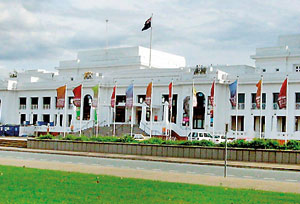From the New Parliament in Canberra we went over to the Old Parliament House –an iconic Australian landmark and home to the Federal Parliament for 61 years – from 1927 to 1988. It was a period when Australia underwent major changes in its social and political life. It is fitting that the building has been turned into a museum devoted to parliamentary affairs.
Taking pride of place is the Museum of Australian Democracy which is not limited to Australia but records significant historical data. A brief history of democracy is featured with attractive display panels starting with the Magna Carta – the 'Great Charter'. This is the 13th century document which was imposed by rebellious barons of England's King John designed to prohibit arbitrary royal acts by declaring a body of defined law and custom which the king had to respect in dealing with all his free subjects.
Historic events are also featured. The English Civil War is an example. It gives prominence to Oliver Cromwell (1599-1658), the English military and political leader best known for his overthrow of the monarchy and temporarily turning England into a republican Commonwealth. After the execution of King Charles I in 1649, Cromwell dominated the short-lived Commonwealth of England, conquered Ireland and Scotland, and ruled as Lord Protector from 1653 until his death in 1658.
The French Revolution, impact of the visionaries and how writers contributed to change the world are among other themes portrayed. There are many books displayed on relevant topics.
Using audio-visual techniques, the story of democracy is presented in a most interesting manner.
A big and bold statement on People Power capsules how democracy evolved.
It says: "A democracy is made up of many voices. Throughout history these voices have had an impact on how we live today. While some have been silenced, many have spoken up about their ideas. Their dreams and passions have given others the courage to speak.
"Democracy is about differences of opinion and being able to express those differences openly."
It ends up by posing the question, "What does democracy mean to you?"
In addition to Australia, other countries, including Sri Lanka are not forgotten. Reference is made to recent events in Sri Lanka.
There are at least eight bronze bas-reliefs of key figures relating to the Federation of Australia. The first is that of the 'Father of Federation', Sir Henry Parkes, who served more than 50 years in public life when he embarked on the most ambitious political cause of his career. After his arrival in Sydney from England in 1839, Parkes campaigned for constitutional reform, for the 'freedom and independence' of his adopted land.
His persuasive talents earned him one of the first seats in the new NSW Legislative Assembly of 1856, and he was in and out of politics and power for the rest of his life, including five terms as Premier. Imposing in stature and a fiery orator, in 1889 Parkes dedicated himself to uniting the separate colonies of Australia under one federal government. He was one of the most vigorous and eloquent advocates for the establishment of the Commonwealth of Australia.
We walked through the House of Representatives and even got a chance of carrying the Mace which is kept in the same place where it was when the House was in session. On the opposite side is the Senate chamber. The two are separated by the Hall of Kings where the sole exhibit is a huge statue of King George V.
The offices of the Prime Minister and the Leader of the Opposition remain where they were. They are not just rooms but arranged in such a way as to give a feel of the day. It is significant that the Prime Minister's office was at the front of the building which meant that he was close to the people with a clear view of any protests on the lawns. "Open democracy was a feature of the building", a brochure mentioned.
The gallery of Prime Ministers of Australia features all of them with their photographs, a brief resume of each, and a few eventful happenings during each one's period of office. Under the title 'Only a few people know what is to be the Prime Minister of Australia', the visitor is introduced to the Gallery thus:
"Each of these people has been unique, bringing their own special qualities to the job. Many of them have come from humble beginnings.
They have had a thirst for education and self-improvement, drive, tenacity, and ambition. Several have been great orators, with the gift to persuade and inspire followers, both in the electorate and in the Cabinet Room. A number have been charismatic and physically fit. Some have been supported by their deep religious beliefs. All have shared a passion to serve the Australian people."
The brochure said that the front steps in the building have been used by royalty, prime ministers and ordinary Australians wanting to get their messages across to politicians. As a former Parliamentary reporter, I was fascinated by the way the Press Gallery had been re-created. More of that later. |


